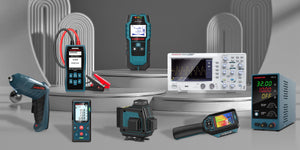
The Best Digital Oscilloscope for Beginners: Top Picks
How to Choose the Best Digital Oscilloscope for Beginners
Introduction
Digital oscilloscopes are essential tools in electronics testing and design. They allow users to visualize electronic signals in real time. For beginners, selecting the right oscilloscope can make a big difference in both ease of use and understanding complex concepts. This guide aims to simplify the process of choosing the best digital oscilloscope for beginners, ensuring that you make an informed decision on your journey into electronics.
Understanding Digital Oscilloscopes
What is a Digital Oscilloscope?
A digital oscilloscope digitizes analog signals, making it possible to visualize waveforms on a screen. It performs various functions like measuring voltage, frequency, and timing. Compared to analog oscilloscopes, which display waveforms on a cathode ray tube, digital oscilloscopes offer better accuracy, precision, and functionality.
Advantages for Beginners
Digital oscilloscopes are user-friendly, making them an excellent choice for newcomers. They often come with features like auto-scaling and various measurement tools that ease the learning curve. Additionally, their digital displays allow for easy interpretation of complex signals. Overall, these oscilloscopes make it straightforward for beginners to experiment and learn effectively.
Key Features to Look For
Display Quality
When selecting the best digital oscilloscope for beginners, display quality is crucial. Look for higher resolution and clarity. A larger screen makes it easier to read waveforms and spot anomalies. The clarity of the display can greatly enhance the learning experience.
Bandwidth and Sample Rate
Understanding bandwidth and sample rate is vital. Bandwidth refers to the range of frequencies the oscilloscope can measure, while sample rate indicates how often the device samples a signal. For DIY projects, aim for a bandwidth of at least 100 MHz. This specification ensures that the oscilloscope can handle most basic electronic signals and projects.
Input Channels
The number of input channels is another key feature. Most beginners will find that a 2-channel oscilloscope meets their needs. However, having more channels allows for more complex measurements and comparisons. Multi-channel oscilloscopes give you the flexibility to analyze different aspects of a signal simultaneously, which can be valuable as you advance.
Top Brands of Digital Oscilloscopes
Leading Brands Overview
Several brands stand out in the digital oscilloscope market. Companies like Tektronix, Rigol, and Keysight are known for their reliability and innovation. They offer various models suited for beginners to professionals. Each of these brands has features that cater specifically to ease of use and performance.
Brand Comparisons
Brand reputation matters when choosing an oscilloscope. Tektronix is highly regarded for its advanced features and durability. Rigol, on the other hand, is often recognized for providing excellent value for beginners. Customer support is another consideration; brands with solid warranty options and support systems can help mitigate potential issues, making them preferable choices for new users.
Best Digital Oscilloscopes for DIY Projects
Recommended Models
When exploring the digital oscilloscope for DIY projects, some models stand out. The Rigol DS1054Z is a favorite among beginners for its affordable price and solid performance. Another great option is the Siglent SDS1202X, known for its intuitive interface and extensive features. These models cater to first-time users while serving all necessary functionality.
Budget Considerations
Finding quality oscilloscopes at different price points is crucial. Beginners don't need to overspend; many reliable oscilloscopes are available in the $200-$500 range. The cost-to-performance ratio is essential – ensure you’re getting features that align with your needs.
Oscilloscope Buying Tips
Where to Buy
When it comes to purchasing, deciding between online and retail stores is essential. Online platforms often have more competitive pricing and a wider selection. Popular online retailers like Amazon and eBay offer reviews and ratings to guide your choice. Always ensure you’re buying from trusted sellers to avoid counterfeit products.
Warranty and Support
For beginners, a product warranty is crucial. Look for oscilloscopes with at least a one-year warranty. This safety net offers peace of mind regarding potential issues. Additionally, checking the brand's customer support ratings can save you headaches if you encounter problems down the road.
How to Use a Digital Oscilloscope
Basic Setup
Getting started with your digital oscilloscope involves basic setup and calibration. Begin by connecting the probes to the signals you want to measure. And always check the manual for specific calibration instructions to ensure accuracy.
Common Applications
Digital oscilloscopes come with a range of applications. Beginners can use them for testing various electronic circuits, debugging designs, and troubleshooting issues. Familiarizing yourself with troubleshooting techniques will enhance your learning, helping you understand how to analyze waveforms effectively.
Conclusion
Choosing the best digital oscilloscope for beginners doesn’t have to be daunting. Remember to consider essential features like display quality, bandwidth, and the number of channels. Explore reputable brands that offer solid support and warranty. As you delve into the world of electronics, don’t hesitate to experiment with different models and features to find the right fit for your projects. Happy oscillating!



Leave a comment